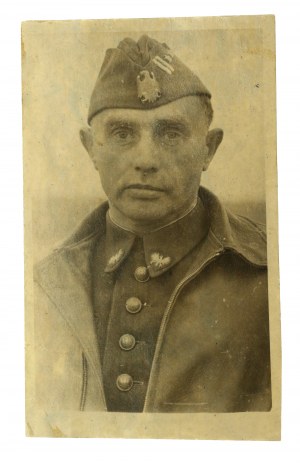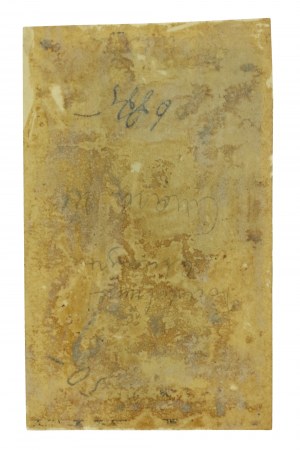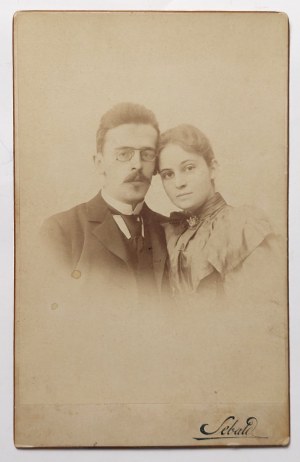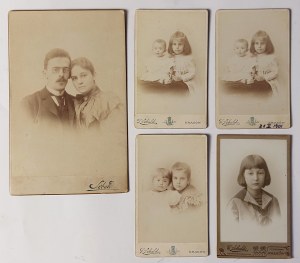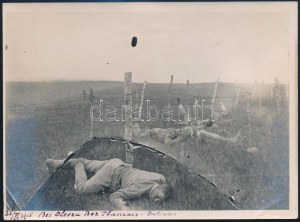[WWI - Lt. Joseph Seruga with telegraph unit - situational photograph]. [1915/1916]. Postcard photograph form. 9x14 cm, of unknown authorship.
Posed photograph of soldiers of the telegraph unit with Lt. Seruga in the center of the first row. On the back, identifying inscriptions in pencil: "x Jozef Seruga subpor 1915/16 during the war with his telegraph unit". Local stains. Rare.
J. Seruga (born January 9, 1886 in Łapczyca, died in spring 1940 in Katyn) - doctor of history, archivist, librarian, lieutenant colonel of communications of the Polish Army, victim of the Katyn massacre. He was born in Łapczyca, in the then Bochnia district of the Kingdom of Galicia and Lodomeria, to a peasant family of Piotr and Maria née Chlebek. In Łapczyca he graduated from primary school, then in 1906 from the State Gymnasium in Bochnia, where he passed his matriculation. During this time he joined and organized independence and underground activities (he hid fugitives from the Russian partition, established a secret passport office). In 1906 he took up studies at the Faculty of Engineering of the Lviv Polytechnic School, which he did not complete. For a year he stayed in the USA, where he worked as a laborer. In 1912 he graduated from the Faculty of Philosophy at the Jagiellonian University. During his studies he was active in the Union of Polish Youth "Zet" (1906-1909), in the organization "Zarzewie" and in the Rifle Squads (1909-1914). During World War I he fought in the ranks of the Imperial and Royal Armies. He was appointed to the rank of second lieutenant with seniority from November 1, 1916 in the infantry reserve officers corps. In 1918, his parent unit was the Telegraph Regiment. In 1916-1918, he worked as a clerk for archival matters and as a conservator of archival monuments with the General Government of Lublin. During the Polish-Bolshevik War, he was commander of telegraph company No. 2 in Zegrze. On September 9, 1920, he was commissioned with the rank of captain, effective April 1, 1920, in the Communications Army Corps, in the group of officers of the former Austro-Hungarian Army. At the time, he was serving in Branch III of the Staff of the Ministry of Military Affairs. On June 1, 1921, he served in the 1st Telegraph Reserve Battalion. In 1924, he served at the Central Works of the Communications Forces in Warsaw as the second deputy head of the works. In January 1925 he was assigned from his home 2nd Communications Regiment in Jaroslaw as deputy regimental commander. On May 3, 1926, he was appointed lieutenant colonel with seniority as of July 1, 1925 and 1st rank in the corps of communications officers[7]. In June 1926, he was assigned to Corps District Command No. V in Cracow as head of communications. In 1928, he was chief of the 5th District Communications Headquarters in Cracow, remaining a supernumerary officer of the 2nd Rifle. In March 1929, he was relieved of his post and left without service affiliation, with simultaneous placement at the disposal of the commander of Corps District No. V. As of August 31, 1929, he was retired. He worked at the Central Military Archives. In 1931 he became custodian of the library and museum collections of the Branicki and Tarnowski families at the castle in Sucha. He specialized in the history of the Polish book in the Renaissance, and researched the history of the Polish military. Together with Zygmunt Hendel, he published a study of an architectural and historical nature of the Church of the Nativity of the Blessed Virgin Mary in Łapczyca (1919). After the outbreak of World War II, during the September campaign, he was wounded during the bombing of Lviv, and after the USSR's aggression against Poland, he was arrested by the Soviets[12]. He was held in the Kozielsk camp. In the spring of 1940, he was taken to Katyn and executed by officers of the Smolensk Regional Board of the NKVD and NKVD personnel arriving from Moscow pursuant to a decision of the Political Bureau of the Central Committee of the Communist Party of the Soviet Union(b) on March 5, 1940. He is buried on the grounds of the present Polish War Cemetery in Katyn. A symbolic grave is located in the Prądnik Czerwony cemetery in Cracow (quarters E-XV-east-5) (Wikipedia).
Recently viewed
Please log in to see lots list
Favourites
Please log in to see lots list



![[WWI - Lt. Joseph Seruga with telegraph unit - situational photograph]. [1915/1916]...](https://img1.one.bid/img/3827/1184222_1q.jpg?1676117954)





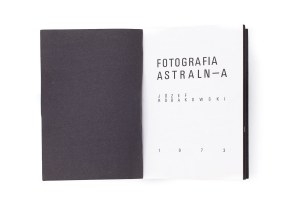

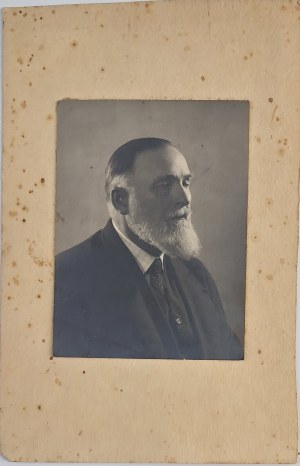
![[PHOTOGRAPHS]. Group of 22 family photographs relating to the families : Aichmüller, Haberman,...](https://img1.one.bid/img/6363/1859651_1x.jpg?1713045600)
